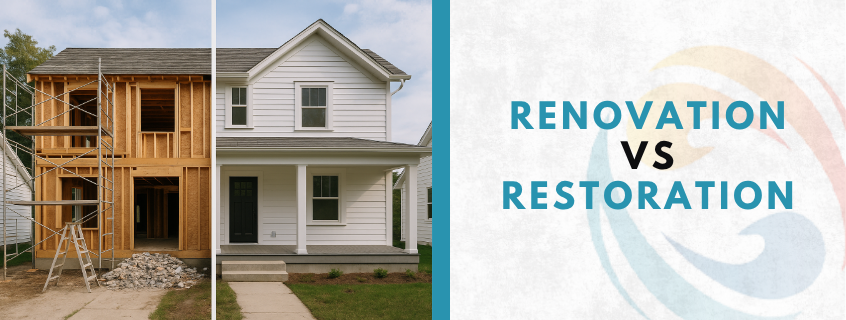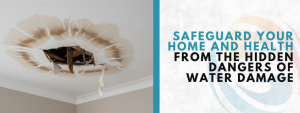
When it comes to fixing up your home, the words “renovation” and “restoration” often get tossed around like they’re the same thing. But they’re not. Knowing the difference between the two could save you thousands of dollars—and maybe even your home. You might think a little paint and polish will do the trick, but sometimes, the damage goes deeper than what you see. This is where understanding renovation vs restoration becomes critical.
Let’s explore five key signs that show your house needs more than a fresh coat of paint. These signs will help you decide if you’re facing a deeper issue that calls for full restoration.
1. Your Walls Talk—And Not in a Good Way
You might notice bubbling paint, cracks that weren’t there before, or strange stains creeping across your walls. These may seem like minor annoyances, but they often signal something serious.
Many homeowners fall into the trap of applying new wallpaper or adding decorative panels without addressing what’s underneath. But here’s the thing—walls don’t just change appearance on their own. Cracks could mean your foundation is shifting. Discoloration might point to hidden moisture or mold. If you ignore these signs, a simple project can become a disaster later.
Here’s how to tell you need more than cosmetic work:
- Paint keeps peeling or bubbling no matter how many times you repaint.
- You smell a musty odor near the walls.
- You spot soft spots or spongy drywall.
These problems hint that it’s time to stop thinking about light renovation and start looking into full restoration. For example, water damage behind your wall panels may not be visible, but it can silently ruin structural wood and insulation. If you’re seeing any of the symptoms above, you might benefit from professional help like this water damage restoration service that focuses on solving the root problem, not just the surface.
And remember, understanding renovation vs restoration helps you avoid covering up a much bigger threat.
2. Flooring That Feels Off—Literally
Have you walked across your floor and suddenly felt a soft spot, a dip, or even a bounce you didn’t expect? Your floor is trying to tell you something.
A warped or sagging floor is more than an eyesore. It’s often a sign of trapped moisture, weakened support beams, or termite damage. You could throw down a new vinyl layer or wood tile to make it look better, but that won’t stop the decay below.
Common warning signs include:
- Sections of your floor squeak or shift.
- You feel uneven dips while walking.
- Boards begin to lift, curl, or separate.
These issues fall into the realm of structural damage. And in this case, restoration is your best bet. If you cover up the symptoms with cosmetic fixes, the underlying problem continues—and worsens. The keyword here is long-term safety. That’s what separates renovation vs restoration every single time.
3. Recurring Moisture or Mold in the Same Spots
Let’s say you clean up some mold in your bathroom or basement. You bleach it, scrub it, and even repaint. A few weeks later, it comes back. That’s not just frustrating—it’s a huge red flag.
Mold doesn’t grow unless the conditions are perfect. Moisture that returns in the same place again and again tells you the root problem isn’t being addressed. It might be a leaking pipe inside a wall, poor ventilation, or even water seeping up through the foundation.
Telltale signs restoration is necessary:
- You clean and dry the area, but mold keeps growing back.
- The air feels heavy and damp, even with a dehumidifier.
- You see dark or green patches on walls, ceilings, or behind furniture.
When mold becomes persistent, it’s not enough to repaint or re-tile. This situation calls for serious restoration. You want someone to track the water source, repair the damage, and completely dry the affected area. For example, if you live in Southern California and experience repeated flooding or leaks, consider turning to experts in Water Damage Restoration Playa Del Rey who specialize in full cleanup and mold prevention.
The choice between renovation vs restoration is clear here—restoration wins when health and safety are involved.
4. Outlets, Lights, or Appliances Acting Strangely
If you’ve ever had a switch that stopped working, lights that flicker, or a socket that feels warm to the touch, it could be more than faulty wiring—it might be a sign your electrical system is compromised.
Aging homes often have outdated wiring that’s not equipped to handle today’s power needs. Worse, leaks or moisture in your walls can corrode wires and cause shorts or even fires. These problems can remain hidden until it’s too late.
Clues your home needs more than a visual upgrade:
- Circuit breakers trip regularly.
- Outlets produce sparks or feel hot.
- You hear buzzing from inside walls or light fixtures.
Fixing a broken outlet is one thing. But if the whole system is suffering, that’s where renovation vs restoration becomes essential to understand. You’re no longer just improving looks—you’re protecting lives.
Restoration means checking the entire electrical infrastructure, upgrading wiring, and making sure your home is safe for years to come. Cosmetic upgrades like a new chandelier mean nothing if the wires behind it are a fire risk.
5. You Smell Trouble—Literally
Sometimes, the most telling sign is one you can’t see—it’s what you smell.
A persistent foul odor—whether it’s damp, sour, smoky, or sewage-like—is a clear sign that something is very wrong behind the scenes. Maybe it’s mold, maybe it’s rotting wood, or maybe it’s something else decaying deep inside your walls, ceilings, or plumbing.
What your nose might be telling you:
- Smells get worse after rain or when humidity rises.
- The odor seems to come from vents, baseboards, or crawl spaces.
- Air fresheners don’t help at all.
Trying to mask the smell with candles or sprays is only a temporary fix. Smells usually indicate that decay is already present. And this is where renovation vs restoration hits home hard. You don’t just want to fix what’s visible—you want to eliminate the source entirely.
Calling in experts to inspect and restore problem areas can bring peace of mind and fresh air—literally.
Quick Comparison: Renovation vs Restoration
Here’s a helpful table to understand the core differences:
| Feature | Renovation | Restoration |
| Purpose | Improves appearance | Repairs structural/functional issues |
| Example Tasks | Repainting, retiling, installing cabinets | Fixing rot, mold remediation, replacing joists |
| Tools Used | Cosmetic (paint, tiles, fixtures) | Heavy-duty (dryers, dehumidifiers, industrial tools) |
| Professionals Involved | Interior designers, contractors | Structural engineers, restoration techs |
| Average Cost | Lower, unless luxury materials used | Higher due to labor and severity |
As you can see, one is about beauty and style, while the other is about safety and stability. Knowing the right choice can protect your investment and your health.
Popular Wood Wall Panels You Might Consider Post-Restoration
If your home has gone through a full restoration, you might be excited to bring the aesthetics back. Here’s a list of popular wood wall panel styles to consider:
- Shiplap: Horizontal wooden boards that add a rustic farmhouse look.
- Board and Batten: Vertical lines that give a timeless, clean profile.
- Beadboard: Small grooves that offer texture and detail for cozy spaces.
- Reclaimed Wood Panels: Made from salvaged wood, perfect for eco-friendly homes.
- 3D Textured Panels: Adds depth and character to modern rooms.
Tip: Only install wood panels after your walls are fully dried and restored. Covering wet or damaged drywall with wood will only lead to worse issues later.
A-Z Glossary: Wood Wall Paneling Terms
Here’s a quick glossary to help with shopping and discussions:
- A – Acclimation: The process of letting wood adjust to a room’s temperature and humidity before installation.
- B – Battens: Narrow strips used to cover joints between panels.
- C – Crown Molding: Decorative trim installed at the top of wall panels.
- D – Dry Rot: A type of fungus that destroys wood, usually hidden behind walls.
- E – Engineered Wood: Layers of real wood bonded together for better strength and stability.
When to Choose Restoration Over Renovation
A general rule of thumb is this: if there’s damage to your home’s structure, health risks like mold, or recurring moisture problems, go with restoration. If everything is sound and you just want a fresh new look, renovation is fine.
Still unsure? Ask yourself these questions:
- Is there a history of leaks, flooding, or fire?
- Do you see or smell signs of mold or decay?
- Are there frequent electrical or plumbing problems?
If you answered yes to any of these, restoration is probably the safer bet. And if you’re dealing with damage caused by water, you should check out this trusted restoration service to get started the right way.
Conclusion: Don’t Let Looks Fool You
A beautiful home should be more than skin deep. While renovation gives you the look you want, restoration gives you the safety you need. Knowing when to choose one over the other isn’t just smart—it’s vital.
The key takeaway from this is that renovation vs restoration isn’t a trendy design debate. It’s a decision that affects your family’s comfort, health, and long-term safety. Whether you’re redoing your living room or fixing up a flood-damaged basement, make sure you’re making the right kind of change.
And when in doubt, talk to a restoration expert. Especially in areas prone to water damage, like Water Damage Restoration Playa Del Rey, it pays to know what you’re dealing with behind those walls.
Stay smart. Stay safe. And always look deeper than the surface.
Frequently Asked Questions: Renovation vs Restoration – What Homeowners Need to Know
How do I know if I need restoration instead of just renovation?
If you notice recurring mold, water damage, structural cracks, or electrical issues, restoration is likely needed. These problems often signal deeper damage that cosmetic fixes won’t resolve.
What’s the main difference between renovation and restoration?
Renovation focuses on improving appearance, while restoration repairs damage and brings things back to a safe, original state. Think of renovation as updating style, and restoration as fixing the core.
Can I just cover up damage with new paint or wood panels?
Covering damage without fixing the root cause can make things worse over time. Moisture or rot behind panels can lead to serious health and structural risks later.
How do I find out what’s causing mold or bad smells in my home?
Persistent odors or mold usually come from hidden leaks or poor ventilation. A restoration professional can locate and eliminate the source effectively.
Is restoration more expensive than renovation?
Yes, restoration can be costlier because it often involves fixing structural, electrical, or water damage. But it protects your home long-term and avoids repeated repairs.






